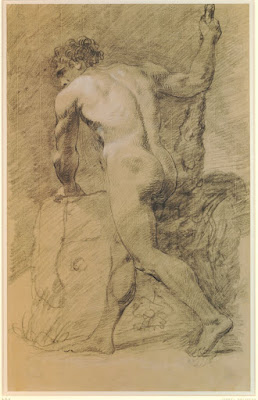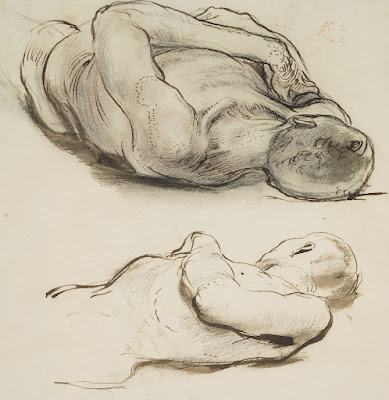 |
| Joseph Highmore Male Nude Seated ca. 1745-50 drawing Tate Britain |
 |
| Joseph Highmore Male Nude Seated, with Raised Arm ca. 1745-50 drawing Tate Britain |
"The dating of academy drawings is notoriously difficult. A number of elements must be taken into account, including the medium and paper used, size, the artist's drawing style as it develops during his career, his studio training, his membership in academies, the physiognomy of the model (and his or her distinctive anatomical features), and finally the model's pose and paraphernalia depicted in the drawing. Highmore's Male Nude Seated with Raised Arm is a good example of a drawing which raises such problems. Nonetheless it can be stated confidently that this drawing and its companion were not executed from the life at an academy of art. Rather, with its high degree of finish, it looks to have been made as an illustration for an unexecuted theoretical treatise."
 |
| Allan Ramsay Seated Model ca. 1737 drawing Scottish National Gallery, Edinburgh |
 |
| Allan Ramsay Model Half-Reclining ca. 1754-56 drawing Scottish National Gallery, Edinburgh |
 |
| Allan Ramsay Female Model Seated ca. 1758 drawing Scottish National Gallery, Edinburgh |
"While Ramsay's drawing style during his first Italian sojourn (1736-38) was similar to the precise draughtsmanship of Pompeo Batoni, whose studies have been mistaken for Ramsay's own, later studies exhibit a much freer handling and heavier hatching, which is closer to contemporary French draughtsmanship."
 |
| Joshua Reynolds Standing Model ca. 1750-60 drawing British Museum |
 |
| Joshua Reynolds Female Model Half-Length ca. 1760-70 drawing British Museum |
 |
| Joshua Reynolds Standing Model with Club of Hercules ca. 1770-80 drawing British Museum |
 |
| Joshua Reynolds Model pulling a Rope ca. 1770-80 drawing British Museum |
"Although he stressed the careful attention which students should pay to the model, Reynolds nevertheless believed that a drawing of the living figure ought not to be 'the representation of an individual, but of a class.' In this respect the model was to be treated no differently than the casts from which students drew in the Antique Academy. It was indeed a commonplace throughout the period to equate the study of the living model with statuary, as the following description by Reynolds' pupil, James Northcote, indicates: 'The stillness, the artificial light, the attention to what they are about, the publicity even, draws off any idle thoughts and they [the students] regard the figure and point out its defects or beauties precisely as if it were clay or marble."
 |
| Richard Earlom Reclining Model ca. 1760 drawing British Museum |
 |
| Benjamin West Figure Study for The Crucifixion 1788 drawing (study for painting) Metropolitan Museum of Art, New York |
 |
| James Barry Standing Model posed as Adam ca. 1792-95 drawing (print study) British Museum |
 |
| Joseph Mallord William Turner Figure Study ca. 1799-1805 drawing Tate Britain |
 |
| Joseph Mallord William Turner Figure Study ca. 1799-1805 drawing Tate Britain |
 |
| William Mulready Standing Model ca. 1805 drawing Royal Academy of Arts, London |
"This drawing is one of a large collection of academic studies by William Mulready spanning the period of his studentship in the Royal Academy Schools to his time as Visitor there and at the South Kensington Schools in the early 1860s. Collectively they form possibly the most comprehensive record of a British artist's activity in the Life Class over more than half a century. . . . In 1806 Mulready was awarded a silver medal for drawing, and by 1807 was singled out by George Farington for his ability to draw the human figure. 'Mulready a young man Twenty one or two years of age is reckoned to draw the best, but sets Himself high upon it as if He had done His business.' Farington noted at the same time that Henry Tresham, who was then a Visitor in the Life Schools, thought that he had never seen 'so many good drawings in the Academy at one time before.' Indeed, among the students then attending the Life Class were David Wilke [directly below], Benjamin Robert Haydon, and Constable."
 |
| David Wilkie Half-Length Studies of Recumbent Model ca. 1810 drawing Scottish National Gallery, Edinburgh |
– quoted passages from The Artist's Model: its Role in British Art from Lely to Etty by Ilaria Bignamini and Martin Postle (exhibition catalogue, Nottingham University Art Gallery, 1991)